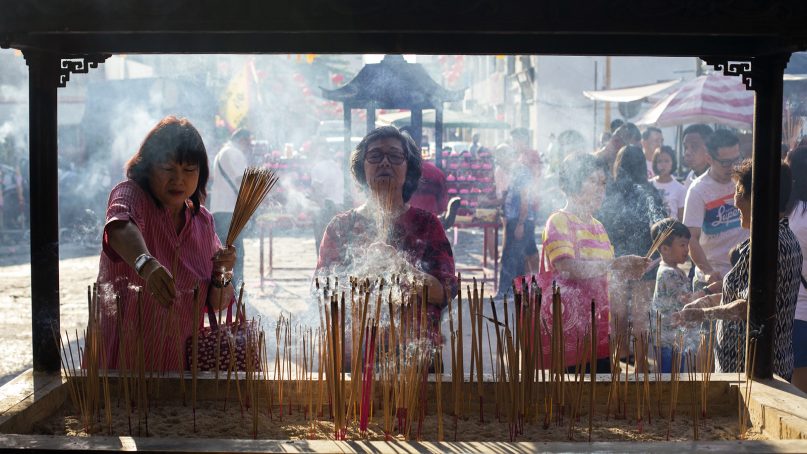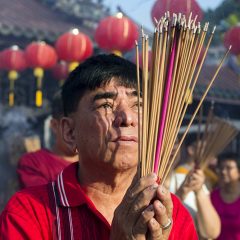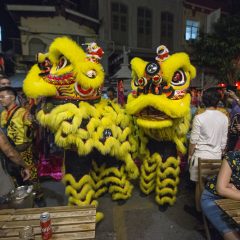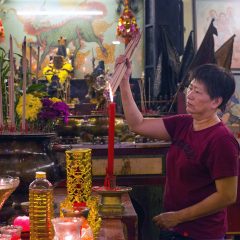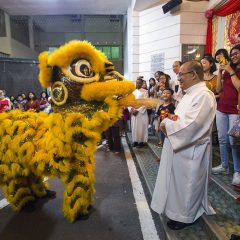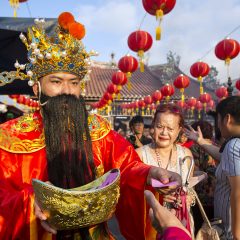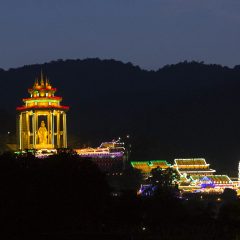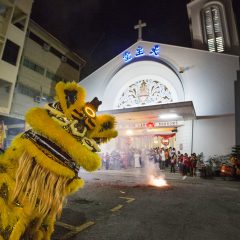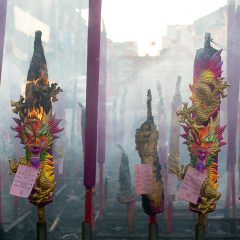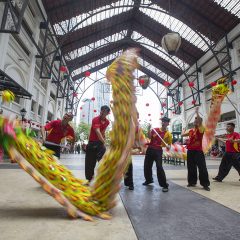(RNS) — The Chinese Lunar New Year, also called the Spring Festival, started more than 3,000 years ago as a harvest festival in the Chinese agrarian society that observed and celebrated the cycles of nature. Throughout millennia, the festival has grown to become the biggest annual celebration in Chinese communities throughout the world.
- On Feb. 5, 2019, the first day of the Lunar New Year, people pray for good luck and abundance at temples around Penang, Malaysia. RNS photo by Alexandra Radu
- A group performs an acrobatic lion dance for Lunar New Year celebrations on one of the main bar streets of Georgetown, the old center of Penang, Malaysia, on Feb. 5, 2019. The lion dance team was brought in and paid by the owners of the businesses on that street, and prior to the performance the lion toured all the businesses on the street that contributed to the performance, spreading blessings. It is believed that a lion entering the building will bring good luck to the place in the coming year. RNS photo by Alexandra Radu
- A woman lights incense sticks at a temple on the seashore in Penang. Some of the Chinese clans built their own jetties, communities and temples — dedicated to gods of the sea — in the old harbor of Penang when it was first settled millennia ago. RNS photo by Alexandra Radu
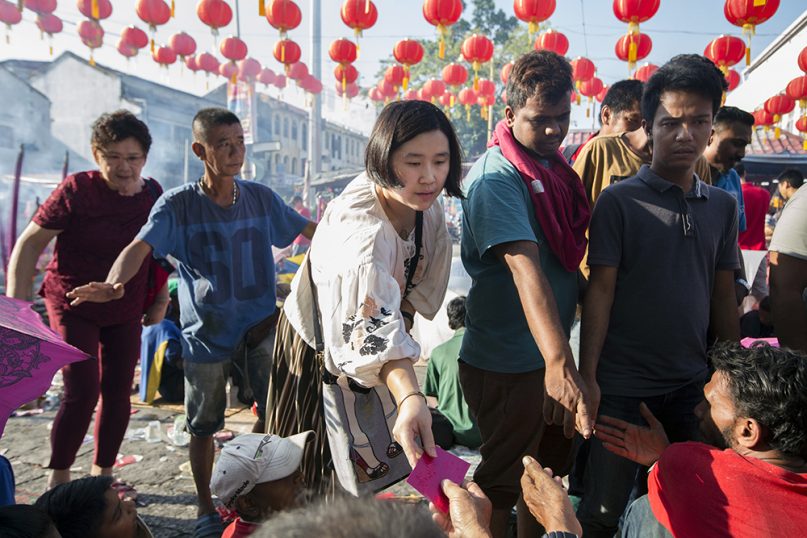
A woman gives away “ang pow,” red envelopes containing small amounts of money, to the needy in front of a temple in Penang, Malaysia, on Feb. 5, 2019, on the first day of the Lunar New Year. People often make donations to the needy during the Spring Festival as a way of giving back to the community and bringing in more prosperity. RNS photo by Alexandra Radu
One of the places that has developed unique Chinese New Year traditions is Penang, in northern Malaysia, the center of Chinese culture in a country whose population is nearly one-quarter ethnic Chinese. Their forebears arrived as traders as early as the 15th century, and their traditions, though distinctive, maintain their connection with ancient customs.
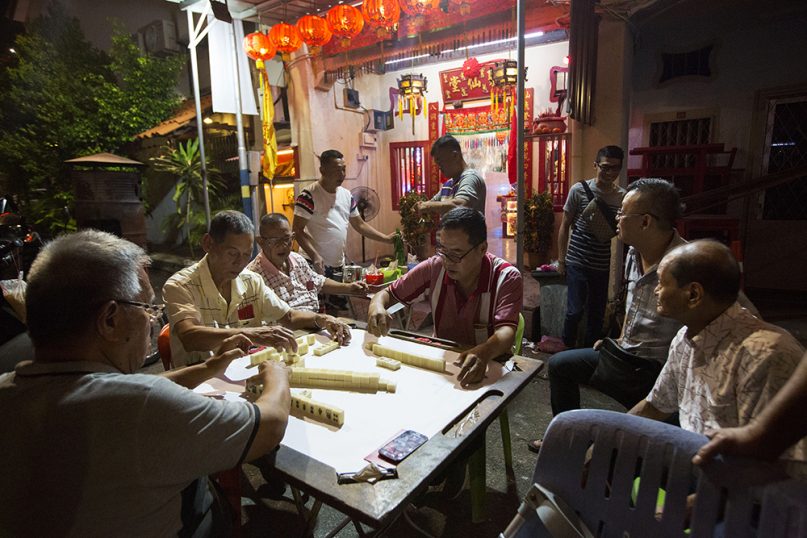
Men play mahjong, a popular game during family reunions, in front of their house in Penang, Malaysia. Families spend much of the Spring Festival time together, often visiting relatives and friends for open houses throughout the Lunar New Year. RNS photo by Alexandra Radu
New year celebrations are famously raucous street festivals, with firecrackers and richly decorated costumes, but for the Malaysian Chinese they are also private, family affairs, a time to clean the house, pay debts of all kinds and start fresh. Children return to their parents’ homes and spend most of the 15 days of the Spring Festival together.
- “We see the lion dance from its cultural background and we don’t integrate it as a part of the elements of local belief. It is a way to celebrate the cultural background of the Chinese Catholics,” said the Rev. Aloysius Tan, of the Church of Our Lady of Sorrows in Penang, Malaysia. “We always do it after the Mass, outside the church, so this is a separation between the religious celebration and the cultural celebration.” RNS photo by Alexandra Radu
- A man dressed as Caishen, the god of wealth, gives away blessings at the Goddess of Mercy Taoist temple in Penang, Malaysia, on Feb. 5, 2019. It is customary on the fifth day of the Lunar New Year to welcome Caishen by symbolically inviting him into houses with firecrackers. RNS photo by Alexandra Radu
- The Kek Lok Si temple, the largest Buddhist temple in Malaysia, lights up in an impressive display of neon lights and around 20,000 Chinese lanterns throughout the Spring Festival. The temple is one of the major attractions for Chinese families reunited in Penang for the Lunar New Year. RNS photo by Alexandra Radu
- A lion dances in front of the Church of Our Lady of Sorrows, one of the traditional Chinese-majority Catholic parishes in Penang, Malaysia, on Feb. 4, 2019. Many of the local Chinese-majority Catholic churches organize commemorations of the ancestors and lion dances after the Mass on the eve of the Lunar New Year. RNS photo by Alexandra Radu
On the eve of the new year, families sit down for a reunion dinner, the centerpiece of which is yee sang, a dish traditionally made from thinly sliced fresh fish. (In Chinese, the word “fish” sounds similar to “abundance.”) In Malaysia, yee sang has evolved into a colorful mix of fish, carrot, radish and other vegetables with colors symbolizing prosperity and good luck.
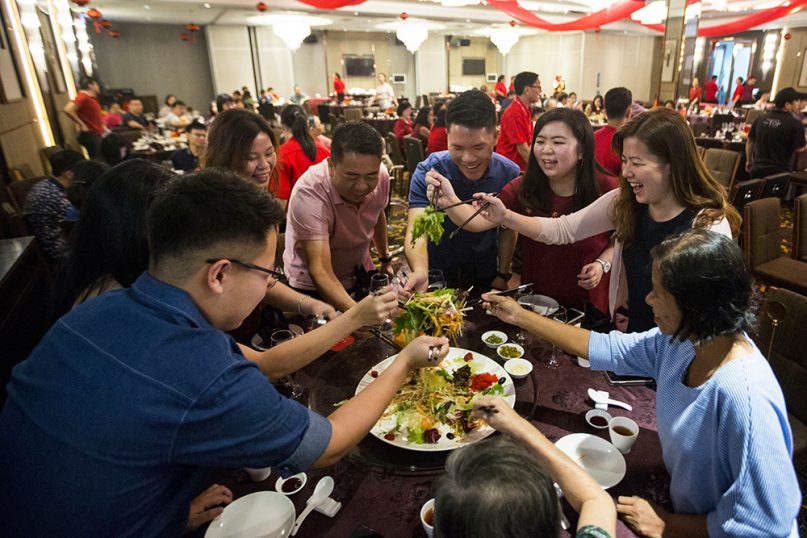
Families toss the yee sang dish at the beginning of a reunion dinner on Feb. 4, 2019. “It is very important for us to be together with our families for the reunion dinner,” said Yee Vone Koy, a young Penangite. “It happens that I am working on this Chinese New Year so my family and I decided to eat out at a restaurant near my office so we can spend the reunion dinner together.” RNS photo by Alexandra Radu
Throughout the two weeks of the Spring Festival, the Malaysian Chinese observe a range of rituals and traditions meant to bring in good luck, prosperity and wealth.
- Large decorated joss sticks with blessing wishes burn in front of a temple in Penang during the first day of the Chinese Lunar New Year on Feb. 5, 2019. RNS photo by Alexandra Radu
- Members of the Hoon Quan Wushu club perform a dragon dance ahead of the Lunar New Year in Penang, Malaysia. Dragons are a symbol of strength and good luck, and dragon dances are performed wishing blessings to the community. “We are all into martial arts and perform dragon and lion dances as a hobby,” said Peter Ep Ooi, assistant instructor of the Hoon Quan Wushu club. “We always show our skills through both lion and dragon dances for Chinese New Year but I personally prefer the dragon dance, as it is all about team work.” RNS photo by Alexandra Radu
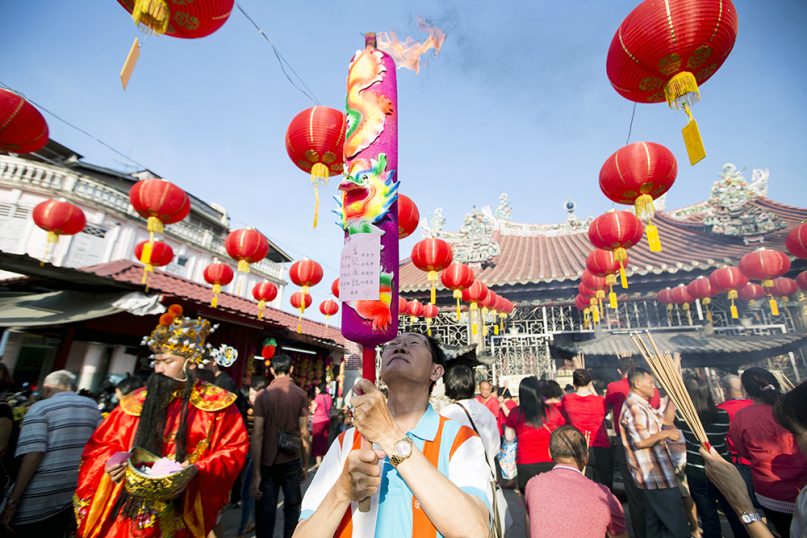
People pray on the Lunar New Year morning at the Goddess of Mercy temple on Feb. 5, 2019, in Penang, Malaysia, the oldest Taoist temple in the city. RNS photo by Alexandra Radu
